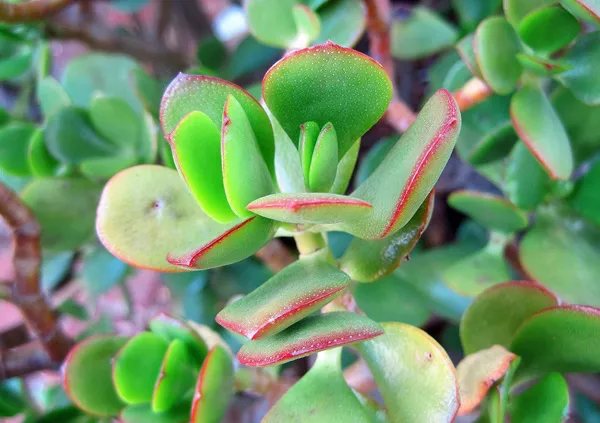Crassula succulents are popular houseplants due to their attractive appearance and low-maintenance needs. They belong to the Crassulaceae family and include species like Crassula ovata (Jade Plant), Crassula perforata (String of Buttons), and Crassula capitella (Campfire Plant). These plants store water in their thick leaves, making them drought-resistant and perfect for beginners.
To keep Crassula succulents healthy and thriving, it is essential to provide the right growing conditions and proper care. This guide will explain how to care for Crassula succulents in detail.
1. Light Requirements
Crassula succulents need plenty of sunlight to grow well. They thrive in bright, indirect light but can also handle direct sunlight. Here are some important light considerations:
- Indoor Placement: Place Crassula near a sunny window, preferably south- or west-facing. If natural light is insufficient, use a grow light.
- Outdoor Placement: When grown outside, position them in a spot with partial to full sun. Morning sun is ideal, but harsh afternoon sun may cause sunburn.
- Signs of Light Problems: If the plant stretches or becomes leggy, it needs more light. If the leaves turn red or brown, they may be receiving too much direct sun.
2. Watering Needs
Watering is one of the most critical aspects of Crassula care. These succulents are drought-tolerant and require minimal watering.
- Watering Frequency: Water only when the soil is completely dry. This usually means once every 1-2 weeks in summer and once a month in winter.
- Watering Method: Use the “soak and dry” method—water the soil thoroughly until water drains out from the bottom, then let it dry completely before the next watering.
- Avoid Overwatering: Overwatering can lead to root rot. Signs of overwatering include yellowing leaves, mushy stems, and a rotten smell.
- Signs of Underwatering: If the leaves wrinkle or shrivel, the plant needs more water.
3. Soil Requirements
Proper soil ensures healthy root growth and prevents root rot.
- Best Soil Type: Use a well-draining succulent or cactus mix.
- DIY Soil Mix: Mix potting soil with sand, perlite, or pumice to improve drainage.
- Avoid Retaining Moisture: Do not use regular potting soil, as it retains too much water and can cause root problems.
4. Pot Selection
The right pot helps Crassula succulents grow properly and prevents water retention.
- Drainage Holes: Always use a pot with drainage holes to allow excess water to escape.
- Pot Material: Terracotta or ceramic pots are best because they allow soil to dry faster than plastic pots.
- Pot Size: Choose a pot slightly larger than the root ball. A too-large pot retains excess moisture, increasing the risk of root rot.
5. Temperature and Humidity
Crassula succulents prefer warm temperatures and low humidity.
- Ideal Temperature: Keep them in temperatures between 60-80°F (15-27°C). They do not tolerate frost.
- Winter Care: If temperatures drop below 50°F (10°C), bring outdoor plants inside.
- Humidity Levels: Crassula prefers dry air. High humidity can cause fungal diseases, so ensure good air circulation.
6. Fertilizing
Crassula plants do not need frequent fertilizing, but occasional feeding boosts growth.
- Best Fertilizer: Use a diluted liquid fertilizer formulated for succulents.
- Fertilizing Schedule: Feed once every 2-3 months during the growing season (spring and summer). Do not fertilize in winter when growth slows.
- Avoid Over-Fertilizing: Too much fertilizer can cause weak, leggy growth.
7. Pruning and Maintenance
Regular pruning keeps Crassula succulents healthy and attractive.
- Remove Dead Leaves: Trim dead or yellowing leaves to prevent pests and diseases.
- Shape the Plant: Prune leggy stems to encourage bushier growth.
- Propagation from Cuttings: Cut healthy stems and let them dry for a few days before planting in soil.
8. Propagation
Crassula succulents are easy to propagate, making them perfect for expanding your plant collection.
- Stem Cuttings: Cut a healthy stem, let it dry for 2-3 days, then plant it in well-draining soil.
- Leaf Cuttings: Gently remove a leaf, let it callous over for a few days, then place it on moist soil.
- Offsets: Some species produce small offsets that can be separated and planted individually.
- Water Lightly: After planting, mist the soil lightly and avoid heavy watering until roots develop.
9. Common Pests and Diseases
Crassula succulents are relatively pest-resistant but can sometimes be affected by pests or diseases.
- Mealybugs: Look for white, cotton-like clusters on the leaves. Remove them with alcohol or insecticidal soap.
- Aphids and Spider Mites: These pests suck plant juices and cause yellowing leaves. Wash them off with water or use neem oil.
- Fungal Infections: Overwatering or high humidity can cause root rot and leaf spots. Improve airflow and avoid wet soil.
10. Seasonal Care
Crassula care changes slightly with the seasons.
- Spring and Summer: Increase watering and fertilizing as the plant grows actively.
- Fall: Gradually reduce watering as growth slows.
- Winter: Keep plants dry and avoid fertilizing. Protect from cold temperatures.
Conclusion
Crassula succulents are easy to care for and can thrive with minimal effort. Providing proper light, well-draining soil, careful watering, and occasional feeding will keep them healthy. Watching for pests, pruning as needed, and propagating new plants can enhance their beauty and longevity. With these simple care tips, you can enjoy a thriving Crassula plant for years to come.
Related Topics:


